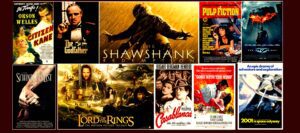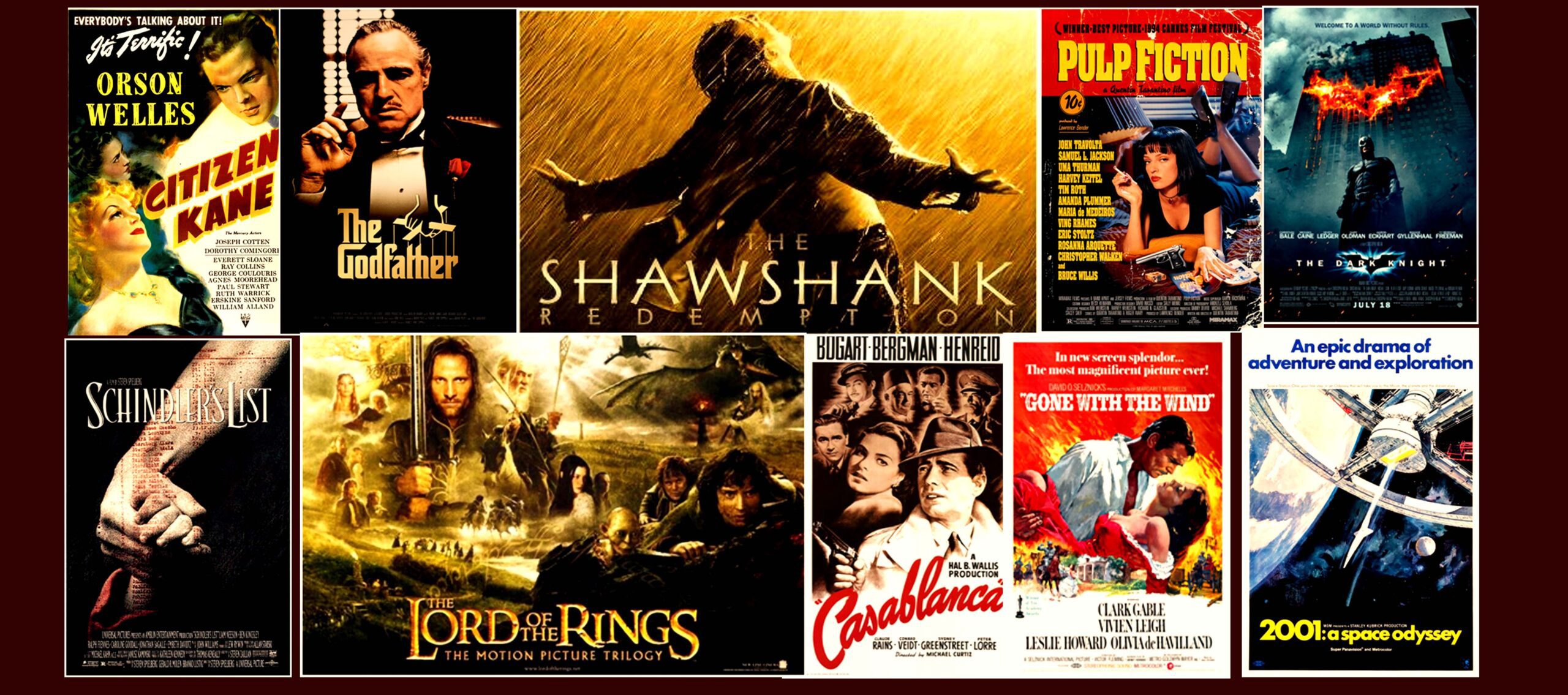
A list of ten highly regarded films that have made significant impacts on the world of cinema.Timeless Masterpieces: Ten Films That Transformed Cinema. Please note that rankings and opinions may vary, and there may have been new releases since then that could also be considered among the best. Here are ten influential films, along with brief descriptions:
1″Citizen Kane” (1941) is widely regarded as one of the greatest films ever made. Directed by Orson Welles, who also co-wrote the screenplay and starred in the film, “Citizen Kane” revolutionized the art of filmmaking and storytelling.
The film follows the life of Charles Foster Kane, a wealthy newspaper tycoon based on the real-life figure of William Randolph Hearst. Through a non-linear narrative structure, the story delves into Kane’s rise to power and subsequent decline, exploring themes of ambition, corruption, and the elusive nature of truth.
“Citizen Kane” is notable for its innovative techniques, such as deep focus cinematography, low-angle shots, and inventive use of editing. It also showcases Welles’ remarkable performance as Kane, capturing the character’s charisma, complexity, and the emptiness that lies beneath his public persona.
The film received critical acclaim upon its release but initially faced challenges at the box office. However, over time, its reputation grew, and it is now recognized as a landmark in cinematic history. “Citizen Kane” is often praised for its exceptional craftsmanship, compelling storytelling, and its exploration of themes that continue to resonate with audiences to this day.
2″The Godfather” (1972) is a crime drama film directed by Francis Ford Coppola and based on the novel by Mario Puzo. It is widely regarded as one of the greatest films ever made and has had a significant impact on popular culture.
Set in the world of organized crime, “The Godfather” follows the Corleone family, led by patriarch Vito Corleone (Marlon Brando). The story revolves around the themes of power, loyalty, family, and the dark underbelly of the American dream. As Vito’s son, Michael Corleone (Al Pacino), becomes more involved in the family’s criminal activities, the film delves into his transformation from a reluctant outsider to a ruthless leader.
“The Godfather” is known for its exceptional writing, compelling performances, and meticulous attention to detail. It masterfully combines elements of drama, suspense, and tragedy, creating a rich and immersive narrative. The film explores complex characters, their relationships, and the moral dilemmas they face within a world of violence and betrayal.
With its iconic scenes, memorable quotes, and its portrayal of the mafia, “The Godfather” has become deeply ingrained in popular culture. It spawned two highly acclaimed sequels, further expanding the Corleone saga. The film’s influence can be seen in subsequent works, both within the crime genre and in filmmaking as a whole.
“The Godfather” has received numerous awards and accolades, including three Academy Awards, including Best Picture. It continues to captivate audiences with its powerful storytelling, memorable characters, and its exploration of timeless themes that transcend the boundaries of the crime genre.
3.”The Shawshank Redemption” (1994) is a drama film directed by Frank Darabont, based on a novella by Stephen King. Although it didn’t achieve commercial success upon its initial release, the film has gained a cult following over the years and is often regarded as one of the greatest movies of all time.
The story centers around Andy Dufresne (Tim Robbins), a banker who is wrongfully convicted of murder and sentenced to life in Shawshank State Penitentiary. In prison, Andy befriends Red (Morgan Freeman), an inmate who becomes his closest ally. The film explores their enduring friendship and Andy’s relentless pursuit of hope and redemption in the face of injustice and adversity.
“The Shawshank Redemption” examines themes of resilience, friendship, and the human capacity for change. It portrays the harsh realities of prison life, while also highlighting the power of hope and the importance of holding onto one’s dreams.
The film’s narrative is compelling, with well-developed characters and a carefully crafted plot that keeps viewers engaged throughout. It strikes a balance between poignant drama, moments of levity, and thought-provoking social commentary.
“The Shawshank Redemption” is known for its superb performances, particularly by Tim Robbins and Morgan Freeman, who deliver nuanced and memorable portrayals of their respective characters. The film also benefits from its evocative cinematography, capturing the oppressive atmosphere of the prison as well as the fleeting moments of beauty and freedom.
While initially overlooked at the box office, “The Shawshank Redemption” gained widespread acclaim through word-of-mouth recommendations and subsequent home video releases. It has since become a beloved classic, frequently topping lists of the best films ever made and resonating with audiences worldwide.
The film’s enduring popularity can be attributed to its timeless themes, heartfelt storytelling, and the powerful message it conveys about the indomitable nature of the human spirit.
4.”Pulp Fiction” (1994) is a highly influential crime film written and directed by Quentin Tarantino. Known for its nonlinear narrative, eclectic characters, and memorable dialogue, “Pulp Fiction” revitalized independent filmmaking and became a cultural phenomenon.
The film weaves together multiple interconnected storylines, following the lives of various characters involved in crime and violence in Los Angeles. Through its non-linear structure, “Pulp Fiction” explores themes of redemption, morality, and the blurred lines between right and wrong.
The ensemble cast includes John Travolta, Uma Thurman, Samuel L. Jackson, and Bruce Willis, among others. Each actor delivers captivating performances, breathing life into their eccentric and often morally ambiguous characters.
“Pulp Fiction” is renowned for its witty and quotable dialogue, which combines pop culture references, dark humor, and philosophical musings. It subverts traditional storytelling conventions and plays with audience expectations, keeping viewers on the edge of their seats.
The film’s stylish direction, unconventional editing, and eclectic soundtrack contribute to its unique aesthetic. Tarantino’s meticulous attention to detail and his ability to seamlessly blend violence and humor create a distinct and engrossing cinematic experience.
Upon its release, “Pulp Fiction” received widespread critical acclaim and won numerous awards, including the Palme d’Or at the Cannes Film Festival. It continues to be celebrated for its groundbreaking narrative structure, vibrant characters, and its impact on pop culture.
“Pulp Fiction” remains a touchstone of independent cinema, inspiring a new wave of filmmakers and influencing the crime genre. Its enduring legacy lies in its bold storytelling choices, iconic moments, and the indelible mark it has left on the landscape of cinema.
5.”The Dark Knight” (2008) is a superhero film directed by Christopher Nolan and serves as the second installment in Nolan’s Batman trilogy. It is widely regarded as one of the greatest superhero films ever made and has had a significant impact on the genre.
In this gritty and dark interpretation of Batman, Christian Bale reprises his role as the Caped Crusader. The film introduces the iconic character of the Joker, portrayed brilliantly by Heath Ledger, in what would be his final completed performance before his untimely death. The story revolves around Batman’s efforts to combat the Joker’s reign of chaos and destruction in Gotham City.
“The Dark Knight” delves into complex themes such as morality, justice, and the nature of heroism. It explores the blurred lines between good and evil and the sacrifices that are sometimes necessary to uphold principles. The film presents a more grounded and realistic take on the superhero genre, drawing parallels to real-world issues and exploring the psychological depths of its characters.
Ledger’s portrayal of the Joker is widely acclaimed, earning him a posthumous Academy Award for Best Supporting Actor. His interpretation of the character is chilling, unpredictable, and mesmerizing, leaving a lasting impression on audiences. The film also features outstanding performances from the ensemble cast, including Aaron Eckhart as Harvey Dent/Two-Face and Gary Oldman as Commissioner Gordon.
“The Dark Knight” received critical acclaim upon its release, with praise for its dark and complex narrative, visual effects, and performances. It was a commercial success, grossing over a billion dollars worldwide. The film’s impact extended beyond the superhero genre, influencing subsequent films to adopt a darker and more realistic tone.
“The Dark Knight” elevated the superhero genre to new heights and demonstrated that comic book adaptations could be sophisticated, thought-provoking, and artistically crafted. It remains a benchmark for superhero films, praised for its gripping storytelling, memorable performances, and its exploration of deeper thematic elements.
6.”The Lord of the Rings” trilogy (2001-2003) is a series of epic fantasy films directed by Peter Jackson, based on the novels by J.R.R. Tolkien. The trilogy consists of three films: “The Fellowship of the Ring” (2001), “The Two Towers” (2002), and “The Return of the King” (2003). Collectively, these films have had a monumental impact on the world of cinema and have become iconic in the fantasy genre.
“The Lord of the Rings” trilogy transports viewers to the enchanting and perilous world of Middle-earth. The films follow a diverse ensemble of characters, including Frodo Baggins (Elijah Wood), Gandalf the Grey (Ian McKellen), Aragorn (Viggo Mortensen), and many others, as they embark on a quest to destroy the One Ring and save Middle-earth from the forces of darkness.
The trilogy is renowned for its breathtaking visuals, remarkable world-building, and seamless integration of practical effects and groundbreaking CGI. The films showcase epic battles, stunning landscapes, and intricately designed creatures, all contributing to the immersive experience of Tolkien’s richly imagined universe.
Peter Jackson’s visionary direction and attention to detail bring the story to life, capturing the scale, emotion, and grandeur of the original novels. The trilogy balances moments of intense action with quiet character development, exploring themes of friendship, sacrifice, and the struggle between good and evil.
“The Lord of the Rings” trilogy was a critical and commercial success. It received numerous accolades, including 17 Academy Awards, with “The Return of the King” winning all 11 categories for which it was nominated, including Best Picture. The films resonated with audiences worldwide, capturing their imaginations and fostering a passionate fan base.
Beyond their cinematic achievements, the trilogy’s impact extends to the film industry as a whole. It demonstrated the viability and artistic potential of adapting complex fantasy novels, paving the way for subsequent adaptations. The success of “The Lord of the Rings” trilogy also influenced the way films are marketed and released, with studios adopting the strategy of filming and releasing multiple installments as a continuous narrative.
“The Lord of the Rings” trilogy is a landmark in filmmaking, with its legacy encompassing not only its artistic merits but also its cultural impact. It remains a definitive cinematic achievement, beloved by fans and recognized for its epic storytelling, groundbreaking visuals, and its ability to transport audiences to a world of magic and adventure.
7.”Schindler’s List” (1993) is a historical drama film directed by Steven Spielberg. Based on the true story of Oskar Schindler, a German businessman who saved the lives of over a thousand Jewish refugees during the Holocaust, the film is a powerful exploration of heroism, humanity, and the horrors of genocide.
Liam Neeson delivers a compelling performance as Oskar Schindler, a complex character who initially seeks personal gain but undergoes a transformative journey as he witnesses the atrocities committed against the Jewish people. Ralph Fiennes also gives a chilling portrayal of Amon Goeth, a sadistic Nazi officer.
“Schindler’s List” depicts the harsh realities of the Holocaust with unflinching honesty. It offers a stark portrayal of the horrors endured by the Jewish population, capturing the dehumanization, suffering, and loss of life. At the same time, the film emphasizes the triumph of the human spirit and the capacity for compassion in the face of unspeakable evil.
The cinematography of “Schindler’s List” is notable for its stark black-and-white presentation, adding to the film’s somber and haunting atmosphere. Spielberg’s direction expertly balances moments of heart-wrenching drama with nuanced character development and moments of subtle hope.
Upon its release, “Schindler’s List” received widespread critical acclaim and garnered numerous awards, including seven Academy Awards, including Best Picture and Best Director. It is considered one of Spielberg’s finest works and one of the most significant films ever made about the Holocaust.
Beyond its critical acclaim, “Schindler’s List” had a profound impact on raising awareness and promoting discussions about the Holocaust. It is recognized as an essential piece of historical cinema, documenting a dark chapter in human history and serving as a testament to the importance of remembrance and empathy.
“Schindler’s List” continues to be studied and revered for its poignant storytelling, powerful performances, and its ability to provoke deep emotional responses in audiences. It stands as a stark reminder of the atrocities of the Holocaust and a tribute to those who risked their lives to save others.
8.”Casablanca” (1942) is a classic romantic drama film directed by Michael Curtiz. Set during World War II in the Moroccan city of Casablanca, the film tells the story of an American expatriate named Rick Blaine (Humphrey Bogart) who must navigate the complexities of love, politics, and personal sacrifice.
The film centers around Rick’s encounters with his former lover, Ilsa Lund (Ingrid Bergman), and her husband, resistance leader Victor Laszlo (Paul Henreid). As they seek to escape Nazi-occupied Europe, Rick is faced with a moral dilemma: to help the woman he loves or support the cause against the Nazis.
“Casablanca” is celebrated for its exceptional screenplay, memorable dialogue, and iconic characters. The film is renowned for its quotable lines, such as “Here’s looking at you, kid” and “We’ll always have Paris,” which have become ingrained in popular culture.
The chemistry between Bogart and Bergman is palpable, and their performances bring depth and emotion to their characters’ complicated relationship. The supporting cast, including Claude Rains as Captain Louis Renault, adds further richness to the ensemble, creating a captivating and unforgettable ensemble of characters.
The film’s atmospheric setting, filled with intrigue and danger, adds to its allure. The iconic scenes in Rick’s Café Américain and the timeless musical performances of “As Time Goes By” enhance the film’s romantic and nostalgic ambiance.
“Casablanca” was a critical and commercial success upon its release, winning three Academy Awards, including Best Picture. Over time, its reputation has only grown, cementing its status as a cinematic masterpiece.
The film’s enduring appeal lies in its timeless themes of love, sacrifice, and the moral complexities of wartime. It captures the human spirit’s resilience and the power of making difficult choices for the greater good. “Casablanca” continues to enchant audiences with its captivating storytelling, unforgettable characters, and its ability to evoke both nostalgia and a sense of hope in the face of adversity.
9.”Gone with the Wind” (1939) is a historical romance film directed by Victor Fleming and based on the novel by Margaret Mitchell. Set against the backdrop of the American Civil War and Reconstruction era, the film follows the life of Scarlett O’Hara (Vivien Leigh), a headstrong Southern belle, as she navigates love, loss, and survival.
“Gone with the Wind” is notable for its grand scale and sweeping epic narrative. The film captures the tumultuous era with stunning visuals and meticulously crafted period details. From the opulent plantation houses to the sprawling battlefields, the film immerses viewers in the historical context and captures the essence of the Old South.
At the heart of the story is Scarlett O’Hara, a complex and flawed protagonist whose journey spans years of personal and societal upheaval. Vivien Leigh delivers a remarkable performance, bringing depth, charm, and resilience to the iconic character. The film also features notable performances by Clark Gable as Rhett Butler, Olivia de Havilland as Melanie Hamilton, and Hattie McDaniel as Mammy, becoming the first African American to win an Academy Award.
“Gone with the Wind” is known for its lavish production values, including its elaborate costumes, sweeping cinematography, and memorable musical score. The film boasts memorable moments and iconic lines that have become part of popular culture, such as Scarlett’s defiant declaration, “As God is my witness, I’ll never be hungry again!”
Upon its release, “Gone with the Wind” was an enormous commercial success and remains one of the highest-grossing films of all time when adjusted for inflation. It received critical acclaim, winning eight Academy Awards, including Best Picture, and has had a lasting impact on the film industry.
While the film has faced criticism for its portrayal of race and its romanticized depiction of the Old South, “Gone with the Wind” is regarded as a cinematic triumph, showcasing the power of storytelling and the enduring appeal of epic romances. It continues to be recognized as a classic, captivating audiences with its grandeur, unforgettable characters, and its exploration of love and survival amidst the backdrop of a changing world.
10″2001: A Space Odyssey,” directed by Stanley Kubrick, is a groundbreaking science fiction film that continues to captivate audiences with its visionary storytelling and stunning visual effects. Released in 1968, the film is a thought-provoking exploration of human evolution, artificial intelligence, and the mysteries of the universe.
The film unfolds in four distinct acts, each depicting a different stage of human history and evolution. From the prehistoric era to the far reaches of space, “2001: A Space Odyssey” takes viewers on a mesmerizing journey through time and space, challenging their perceptions and raising profound questions about the nature of existence.
The film’s iconic sequences, such as the dawn of man with the discovery of the monolith, the space voyage to Jupiter aboard the Discovery One spacecraft, and the enigmatic Star Gate sequence, are renowned for their visual splendor and thematic depth. The meticulously crafted special effects, including the innovative use of miniatures and practical models, set a new standard for cinematic realism and continue to inspire filmmakers to this day.
“2001: A Space Odyssey” is a largely dialogue-light film that relies heavily on its striking visuals and the power of its haunting musical score, featuring compositions by Richard Strauss and Johann Strauss II. The film’s use of classical music, particularly Richard Strauss’s “Also sprach Zarathustra” and Johann Strauss II’s “The Blue Danube,” has become synonymous with grandeur and cosmic exploration.
While initially met with mixed critical reception upon its release, “2001: A Space Odyssey” has since gained recognition as a seminal work of cinema. It has influenced countless filmmakers and has become a touchstone for science fiction storytelling, pushing the boundaries of what is possible in filmmaking and challenging audiences to ponder humanity’s place in the vastness of the universe.
The film’s enigmatic ending, which features a transcendental journey through time and space, invites interpretation and contemplation, leaving audiences with a sense of wonder and a profound sense of the unknown.
“2001: A Space Odyssey” remains a cinematic masterpiece that continues to awe and inspire audiences with its visual splendor, philosophical depth, and audacious ambition. It stands as a testament to Stanley Kubrick’s visionary genius and his ability to create a film that transcends the boundaries of its genre, making it a timeless classic that will forever be regarded as a pinnacle of cinematic achievement.










